Extraction Optimization and Anti-Tumor Activity of Polysaccharides from Chlamydomonas reinhardtii
Abstract
:1. Introduction
2. Results
2.1. Single-Factor Experiment
2.2. Plackett–Burman Design Analysis
2.3. Response Surface Analysis
2.4. Isolation and Purification of C. reinhardtii Polysaccharides
2.5. UV Spectroscopy Analysis
2.6. Infrared Spectroscopy Analysis
2.7. Toxic Effects of CRP on Vero Cells
2.8. Effect of CRPs on Tumor Cell Proliferation
2.9. Cell Scratch Assay
2.10. DAPI Staining
3. Discussion
4. Materials and Methods
4.1. Materials and Chemicals
4.2. Extraction of Intracellular Polysaccharides from C. reinhardtii
4.3. Determination of Polysaccharide Content
4.4. Single-Factor Experiment
4.5. Plackett–Burman Experimental Design
4.6. Response Surface Design
4.7. Isolation and Purification of Polysaccharides
4.8. Characterization of Intracellular Polysaccharides from C. reinhardtii
4.9. Cell Culture
4.10. Cytotoxicity Assay
4.11. In Vitro Anti-Tumor Activity
4.12. Cell Migration Assay
4.13. DAPI Staining
5. Conclusions
Author Contributions
Funding
Data Availability Statement
Conflicts of Interest
References
- Miller, K.D.; Fidler-Benaoudia, M.; Keegan, T.H.; Hipp, H.S.; Jemal, A.; Siegel, R.L. Cancer statistics for adolescents and young adults, 2020. CA Cancer J. Clin. 2020, 70, 443–459. [Google Scholar] [CrossRef] [PubMed]
- Kaur, R.; Bhardwaj, A.; Gupta, S. Cancer treatment therapies: Traditional to modern approaches to combat cancers. Mol. Biol. Rep. 2023, 50, 9663–9676. [Google Scholar] [CrossRef] [PubMed]
- Zhang, X.; Cui, H.; Zhang, W.; Li, Z.; Gao, J. Engineered tumor cell-derived vaccines against cancer: The art of combating poison with poison. Bioact. Mater. 2023, 22, 491–517. [Google Scholar] [CrossRef]
- Zhu, Y.; Feijen, J.; Zhong, Z. Dual-targeted nanomedicines for enhanced tumor treatment. Nano Today 2018, 18, 65–85. [Google Scholar] [CrossRef]
- Huang, G.; Huang, H. The derivatization and antitumor mechanisms of polysaccharides. Future Med. Chem. 2017, 9, 1931–1938. [Google Scholar] [CrossRef] [PubMed]
- Meng, X.; Liang, H.; Luo, L. Antitumor polysaccharides from mushrooms: A review on the structural characteristics, antitumor mechanisms and immunomodulating activities. Carbohydr. Res. 2016, 424, 30–41. [Google Scholar] [CrossRef] [PubMed]
- Wang, W.; Zhao, B.; Zhang, Z.; Kikuchi, T.; Li, W.; Jantrawut, P.; Feng, F.; Liu, F.; Zhang, J. Natural polysaccharides and their derivatives targeting the tumor microenvironment: A review. Int. J. Biol. Macromol. 2024, 268, 131789. [Google Scholar] [CrossRef] [PubMed]
- Zhang, J.; Liu, L.; Ren, Y.; Chen, F. Characterization of exopolysaccharides produced by microalgae with antitumor activity on human colon cancer cells. Int. J. Biol. Macromol. 2019, 128, 761–767. [Google Scholar] [CrossRef]
- Gao, Y.; Li, Y.; Niu, Y.; Ju, H.; Chen, R.; Li, B.; Song, X.; Song, L. Chemical characterization, antitumor, and immune-enhancing activities of polysaccharide from Sargassum pallidum. Molecules 2021, 26, 7559. [Google Scholar] [CrossRef] [PubMed]
- Tu, J.; He, Y.; Zhang, H.; Wang, J.; Li, Z.; Sun, H. Anti-tumor effect of Crocus sativus petals polysaccharides by reconstructing tumor microenvironment. Int. J. Biol. Macromol. 2023, 248, 125878. [Google Scholar] [CrossRef] [PubMed]
- Liu, Y.; Liu, H.; Sheng, B.; Pan, S.; Wang, Z.-W.; Zhu, X. The functions of lncRNAs in the HPV-negative cervical cancer compared with HPV-positive cervical cancer. Apoptosis 2022, 27, 685–696. [Google Scholar] [CrossRef] [PubMed]
- Kuehn, B. Reducing cervical cancer deaths. JAMA 2019, 322, 198. [Google Scholar] [CrossRef]
- Vora, C.; Gupta, S. Targeted therapy in cervical cancer. ESMO Open 2018, 3, e000462. [Google Scholar] [CrossRef] [PubMed]
- Roszczyk, A.; Turło, J.; Zagożdżon, R.; Kaleta, B. Immunomodulatory properties of polysaccharides from Lentinula edodes. Int. J. Mol. Sci. 2022, 23, 8980. [Google Scholar] [CrossRef]
- Ren, G.; Xu, L.; Zhao, J.; Shao, Y.; Lin, Y.; Li, L.; Liu, Q.; Lu, T.; Zhang, Q. Antiviral activity of Crude polysaccharide derived from Seaweed against IHNV and IPNV in vitro. Viruses 2022, 14, 2080. [Google Scholar] [CrossRef] [PubMed]
- Zhang, S.; Li, Y.; Li, Z.; Liu, W.; Zhang, H.; Ohizumi, Y.; Nakajima, A.; Xu, J.; Guo, Y. Structure, anti-tumor activity, and potential anti-tumor mechanism of a fungus polysaccharide from Fomes officinalis. Carbohydr. Polym. 2022, 295, 119794. [Google Scholar] [CrossRef] [PubMed]
- Ya, G. A Lentinus edodes polysaccharide induces mitochondrial-mediated apoptosis in human cervical carcinoma HeLa cells. Int. J. Biol. Macromol. 2017, 103, 676–682. [Google Scholar] [CrossRef] [PubMed]
- Xu, J.; Tan, Z.-C.; Shen, Z.-Y.; Shen, X.-J.; Tang, S.-M. Cordyceps cicadae polysaccharides inhibit human cervical cancer HeLa cells proliferation via apoptosis and cell cycle arrest. Food Chem. Toxicol. 2021, 148, 111971. [Google Scholar] [CrossRef] [PubMed]
- Liu, Y.; Li, H.; Zheng, Z.; Niu, A.; Liu, S.; Li, W.; Ren, P.; Liu, Y.; Inam, M.; Guan, L.; et al. Rosa rugosa polysaccharide induces autophagy-mediated apoptosis in human cervical cancer cells via the PI3K/AKT/mTOR pathway. Int. J. Biol. Macromol. 2022, 212, 257–274. [Google Scholar] [CrossRef] [PubMed]
- Huang, D.; Cheng, C.-Q.; Qiu, J.-B.; Huang, Y.; Zhang, H.-Y.; Xu, Z.-H.; Wu, S.-W.; Huang, Y.-T.; Chen, J.; Zou, L.-G.; et al. Mechanistic insights into the effects of diuron exposure on Alexandrium pacificum. Water Res. 2024, 250, 120987. [Google Scholar] [CrossRef] [PubMed]
- Balamurugan, S.; Sathishkumar, R.; Li, H.-Y. Biotechnological perspectives to augment the synthesis of valuable biomolecules from microalgae by employing wastewater. J. Water Process Eng. 2021, 39, 101713. [Google Scholar] [CrossRef]
- Masi, A.; Leonelli, F.; Scognamiglio, V.; Gasperuzzo, G.; Antonacci, A.; Terzidis, M.A. Chlamydomonas reinhardtii: A factory of nutraceutical and food supplements for human health. Molecules 2023, 28, 1185. [Google Scholar] [CrossRef] [PubMed]
- Wang, X.; Zhang, H.; Wang, Z.; Bai, H. Optimization of ultrasonic-assisted alkaline extraction of polysaccharides from Phellodendron amurense Rupr. pollen using response surface methodology and its structure features. RSC Adv. 2015, 5, 106800–106808. [Google Scholar] [CrossRef]
- Ma, T.; Sun, X.; Tian, C.; Luo, J.; Zheng, C.; Zhan, J. Polysaccharide extraction from Sphallerocarpus gracilis roots by response surface methodology. Int. J. Biol. Macromol. 2016, 88, 162–170. [Google Scholar] [CrossRef] [PubMed]
- Tang, Z.; Wang, Y.; Huang, G.; Huang, H. Ultrasound-assisted extraction, analysis and antioxidant activity of polysaccharide from the rinds of Garcinia mangostana L. Ultrason. Sonochem. 2023, 97, 106474. [Google Scholar] [CrossRef] [PubMed]
- Wang, S.; Li, G.; Zhang, X.; Wang, Y.; Qiang, Y.; Wang, B.; Zou, J.; Niu, J.; Wang, Z. Structural characterization and antioxidant activity of Polygonatum sibiricum polysaccharides. Carbohydr. Polym. 2022, 291, 119524. [Google Scholar] [CrossRef] [PubMed]
- Zhou, S.; Huang, G. Extraction, structure characterization and biological activity of polysaccharide from coconut peel. Chem. Biol. Technol. Agric. 2023, 10, 15. [Google Scholar] [CrossRef]
- Chen, Y.; Jiang, X.; Xie, H.; Li, X.; Shi, L. Structural characterization and antitumor activity of a polysaccharide from ramulus mori. Carbohydr. Polym. 2018, 190, 232–239. [Google Scholar] [CrossRef]
- Liu, M.; Gong, Z.; Liu, H.; Wang, J.; Wang, D.; Yang, Y.; Zhong, S. Structural characterization and anti-tumor activity in vitro of a water-soluble polysaccharide from dark brick tea. Int. J. Biol. Macromol. 2022, 205, 615–625. [Google Scholar] [CrossRef] [PubMed]
- Yu, J.; Ji, H.; Yang, Z.; Liu, A. Relationship between structural properties and antitumor activity of Astragalus polysaccharides extracted with different temperatures. Int. J. Biol. Macromol. 2019, 124, 469–477. [Google Scholar] [CrossRef] [PubMed]
- Adewale, O.O.; Wińska, P.; Krawczyk, H.; Grzechnik, E.; Cieśla, J. Screening of antioxidative and antiproliferative activities of crude polysaccharides extracted from six different plants. Appl. Sci. 2024, 14, 3683. [Google Scholar] [CrossRef]
- Modimola, M.S.; Green, E.; Njobeh, P.; Senabe, J.; Fouche, G.; McGaw, L.; Nkadimeng, S.M.; Mathiba, K.; Mthombeni, J. Investigating the toxicity of compounds yielded by Staphylococci on Vero cells. Toxins 2022, 14, 712. [Google Scholar] [CrossRef] [PubMed]
- Zhao, Y.; Zheng, Y.; Chen, X.; Du, R.; Yan, Z. Camptothecin derivatives induce apoptosis and inhibit proliferation of prostate cancer PC-3M cells through downregulation of PI3K/Akt signaling pathway. Phytochem. Lett. 2021, 46, 79–89. [Google Scholar] [CrossRef]
- Zhao, Y.; Han, C.; Wu, Y.; Sun, Q.; Ma, M.; Xie, Z.; Sun, R.; Pei, H. Extraction, structural characterization, and antioxidant activity of polysaccharides from three microalgae. Sci. Total Environ. 2024, 931, 172567. [Google Scholar] [CrossRef]
- Park, G.-T.; Go, R.-E.; Lee, H.-M.; Lee, G.-A.; Kim, C.-W.; Seo, J.-W.; Hong, W.-K.; Choi, K.-C.; Hwang, K.-A. Potential anti-proliferative and immunomodulatory effects of marine microalgal exopolysaccharide on various human cancer cells and lymphocytes in vitro. Mar. Biotechnol. 2017, 19, 136–146. [Google Scholar] [CrossRef] [PubMed]
- Wu, H.; Shang, H.; Guo, Y.; Zhang, H.; Wu, H. Comparison of different extraction methods of polysaccharides from cup plant (Silphium perfoliatum L.). Process Biochem. 2020, 90, 241–248. [Google Scholar] [CrossRef]
- Liu, F.; Chen, H.; Qin, L.; Al-Haimi, A.A.N.M.; Xu, J.; Zhou, W.; Zhu, S.; Wang, Z. Effect and characterization of polysaccharides extracted from Chlorella sp. by hot-water and alkali extraction methods. Algal Res. 2023, 70, 102970. [Google Scholar] [CrossRef]
- Cai, B.; Zhao, X.; Luo, L.; Wan, P.; Chen, H.; Pan, J. Structural characterization, and in vitro immunostimulatory and antitumor activity of an acid polysaccharide from Spirulina platensis. Int. J. Biol. Macromol. 2022, 196, 46–53. [Google Scholar] [CrossRef] [PubMed]
- Shang, D.; Li, Y.; Wang, C.; Wang, X.; Yu, Z.; Fu, X. A novel polysaccharide from Se-enriched Ganoderma lucidum induces apoptosis of human breast cancer cells. Oncol. Rep. 2011, 25, 267–272. [Google Scholar] [CrossRef]
- Zhen, D.; Su, L.; Miao, Y.; Zhao, F.; Ren, G.; Mahfuz, S.; Song, H. Purification, partial characterization and inducing tumor cell apoptosis activity of a polysaccharide from Ganoderma applanatum. Int. J. Biol. Macromol. 2018, 115, 10–17. [Google Scholar] [CrossRef] [PubMed]
- Al Monla, R.; Dassouki, Z.; Sari-Chmayssem, N.; Mawlawi, H.; Gali-Muhtasib, H. Fucoidan and alginate from the brown algae Colpomenia sinuosa and their combination with vitamin C trigger apoptosis in colon cancer. Molecules 2022, 27, 358. [Google Scholar] [CrossRef] [PubMed]
- Li, S.; Zhao, Z.; He, Z.; Yang, J.; Feng, Y.; Xu, Y.; Wang, Y.; He, B.; Ma, K.; Zheng, Y.; et al. Effect of structural features on the antitumor activity of plant and microbial polysaccharides: A review. Food Biosci. 2024, 61, 104648. [Google Scholar] [CrossRef]
- Haldar, D.; Sen, D.; Gayen, K. Development of Spectrophotometric Method for the Analysis of multi-component carbohydrate mixture of different moieties. Appl. Biochem. Biotechnol. 2017, 181, 1416–1434. [Google Scholar] [CrossRef] [PubMed]
- Zhang, W.-H.; Wu, J.; Weng, L.; Zhang, H.; Zhang, J.; Wu, A. An improved phenol-sulfuric acid method for the determination of carbohydrates in the presence of persulfate. Carbohydr. Polym. 2020, 227, 115332. [Google Scholar] [CrossRef] [PubMed]
- Li, Z.; Xiao, W.; Xie, J.; Chen, Y.; Yu, Q.; Zhang, W.; Shen, M. Isolation, Characterization and Antioxidant Activity of Yam Polysaccharides. Foods 2022, 11, 800. [Google Scholar] [CrossRef] [PubMed]
- Liu, X.; Pang, H.; Gao, Z.; Zhao, H.; Zhang, J.; Jia, L. Antioxidant and hepatoprotective activities of residue polysaccharides by Pleurotus citrinipileatus. Int. J. Biol. Macromol. 2019, 131, 315–322. [Google Scholar] [CrossRef]
- Liu, C.; Dai, K.-Y.; Li, Z.-T.; Liu, A.-J. Comparison of two kinds of Agrocybe cylindracea polysaccharides: Structural characteristic and antitumor activity. Food Bioprod. Process. 2023, 140, 160–171. [Google Scholar] [CrossRef]
- Mohamed, H.F. Molecular analysis and anticancer properties of two identified isolates, Fusarium solani and Emericella nidulans isolated from Wady El–Natron soil in Egypt against Caco–2 (ATCC) cell line. Asian Pac. J. Trop. Biomed. 2012, 2, 863–869. [Google Scholar] [CrossRef] [PubMed]
- Cholaraj, R.; Venkatachalam, R. Investigation of antioxidant and anticancer potential of fucoidan (in-vitro & in-silico) from brown seaweed Padina boergesenii. Algal Res. 2024, 79, 103442. [Google Scholar] [CrossRef]
- Li, D.-W.; Tan, J.-Z.; Li, Z.-F.; Ou, L.-J. Membrane lipid remodeling and autophagy to cope with phosphorus deficiency in the dinoflagellate Prorocentrum shikokuense. Chemosphere 2024, 349, 140844. [Google Scholar] [CrossRef] [PubMed]


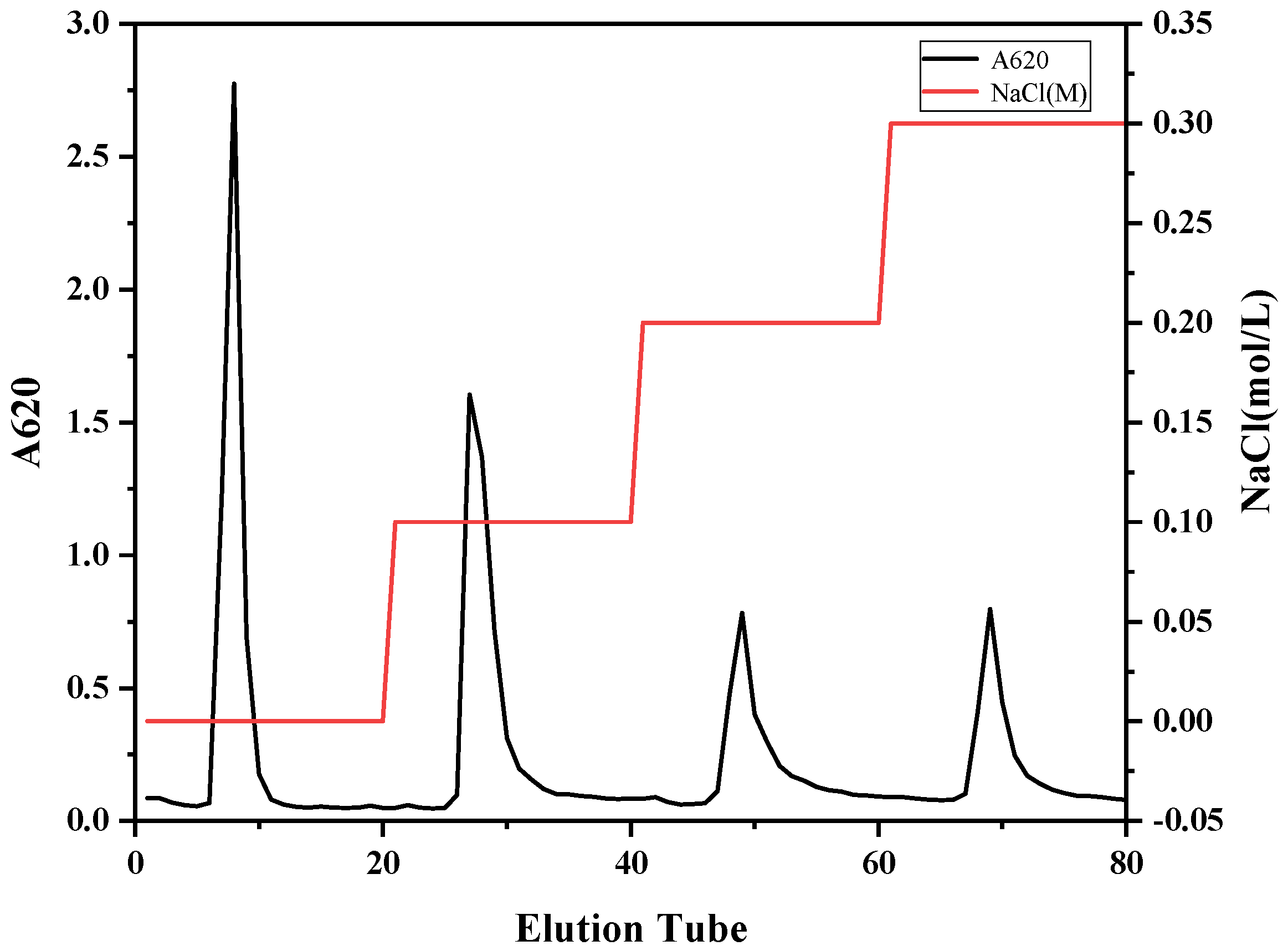
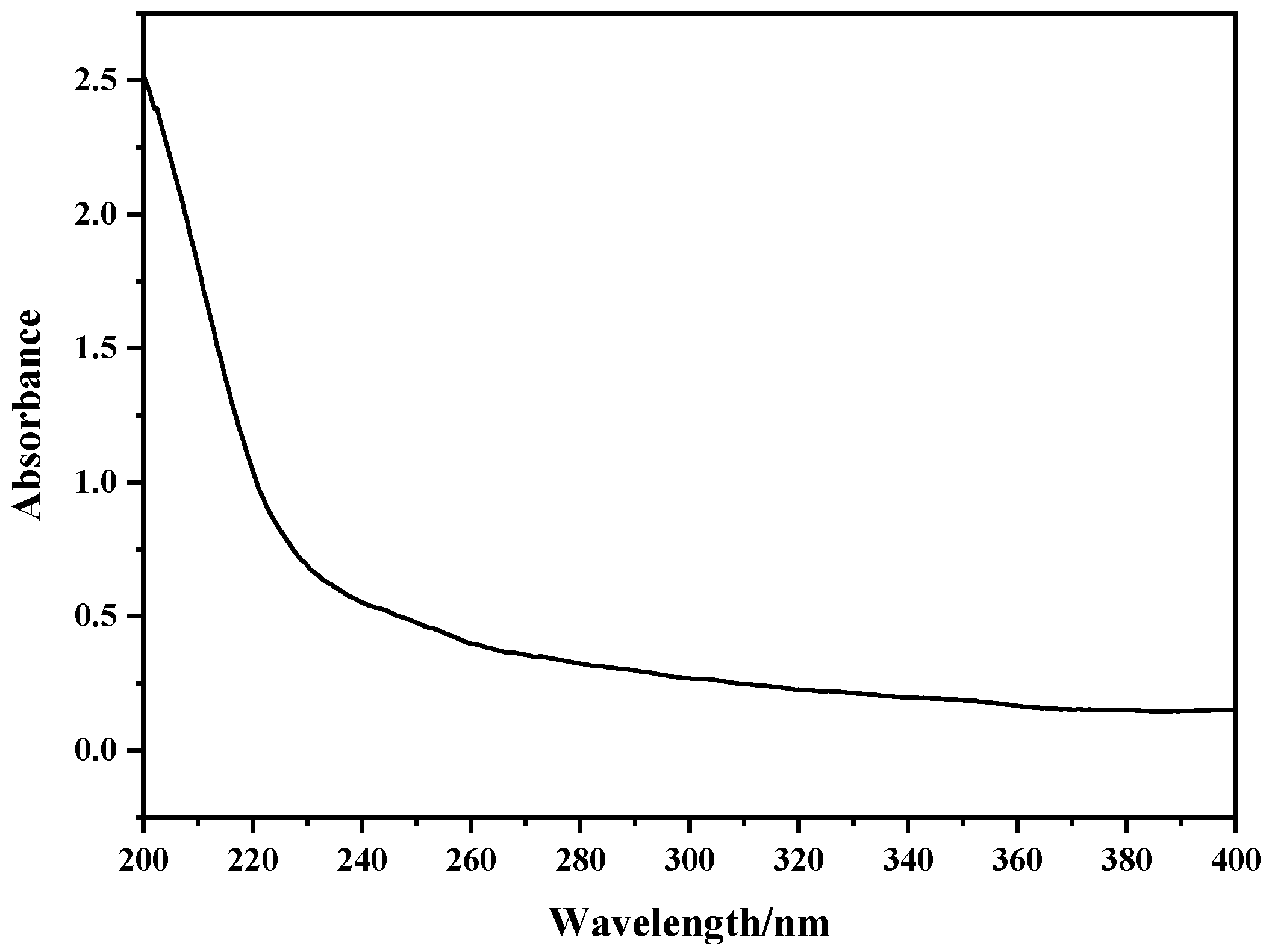


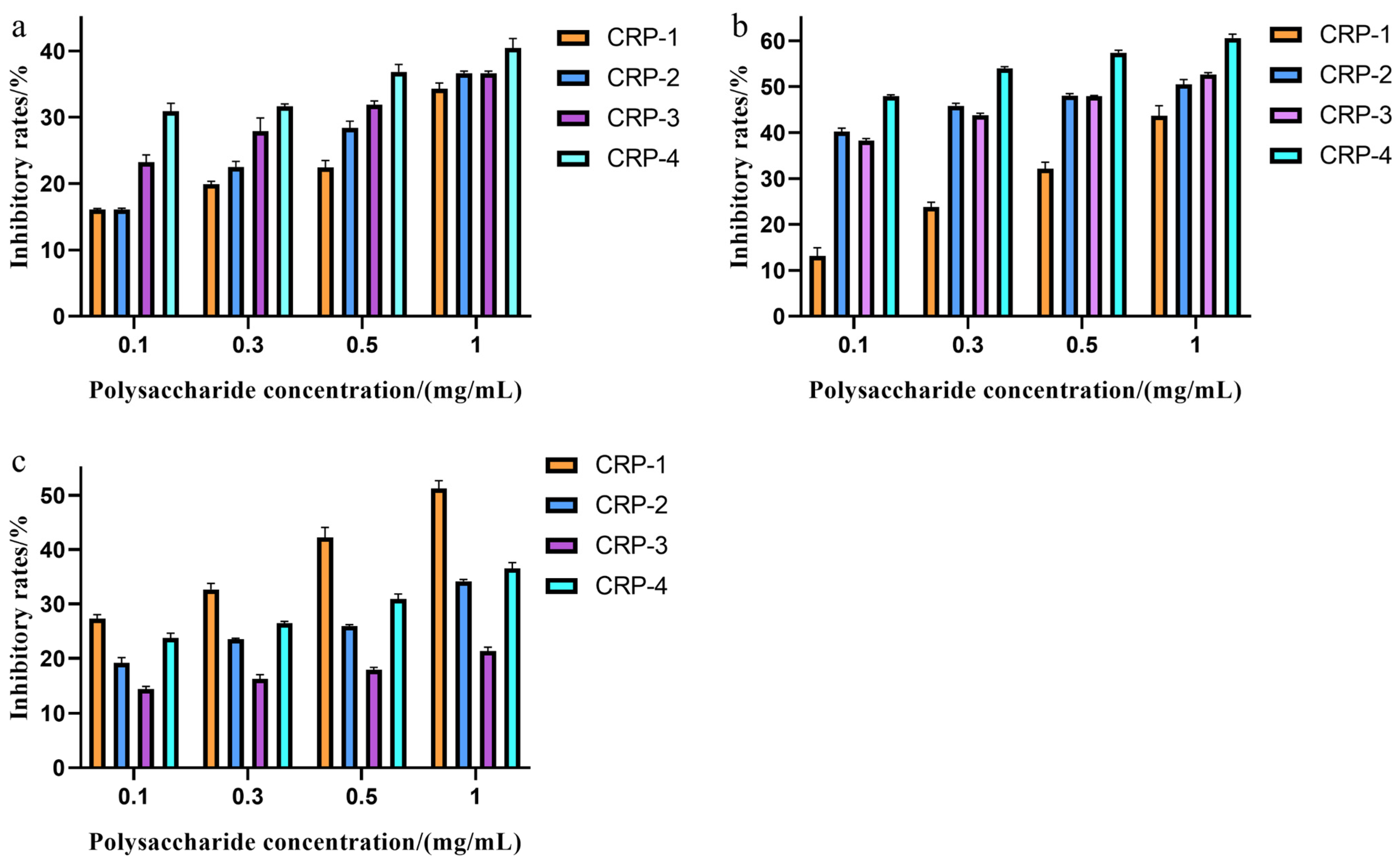
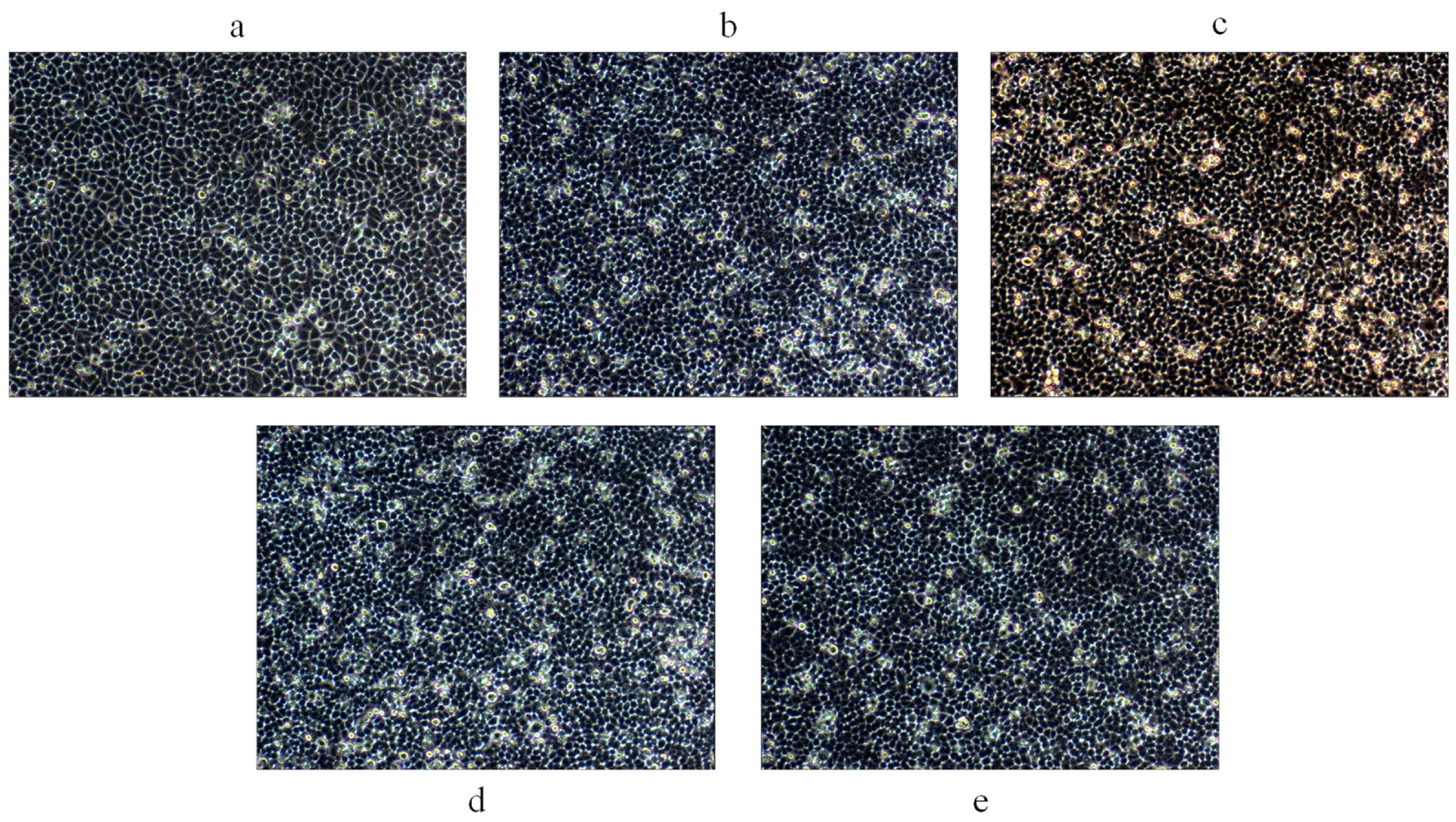


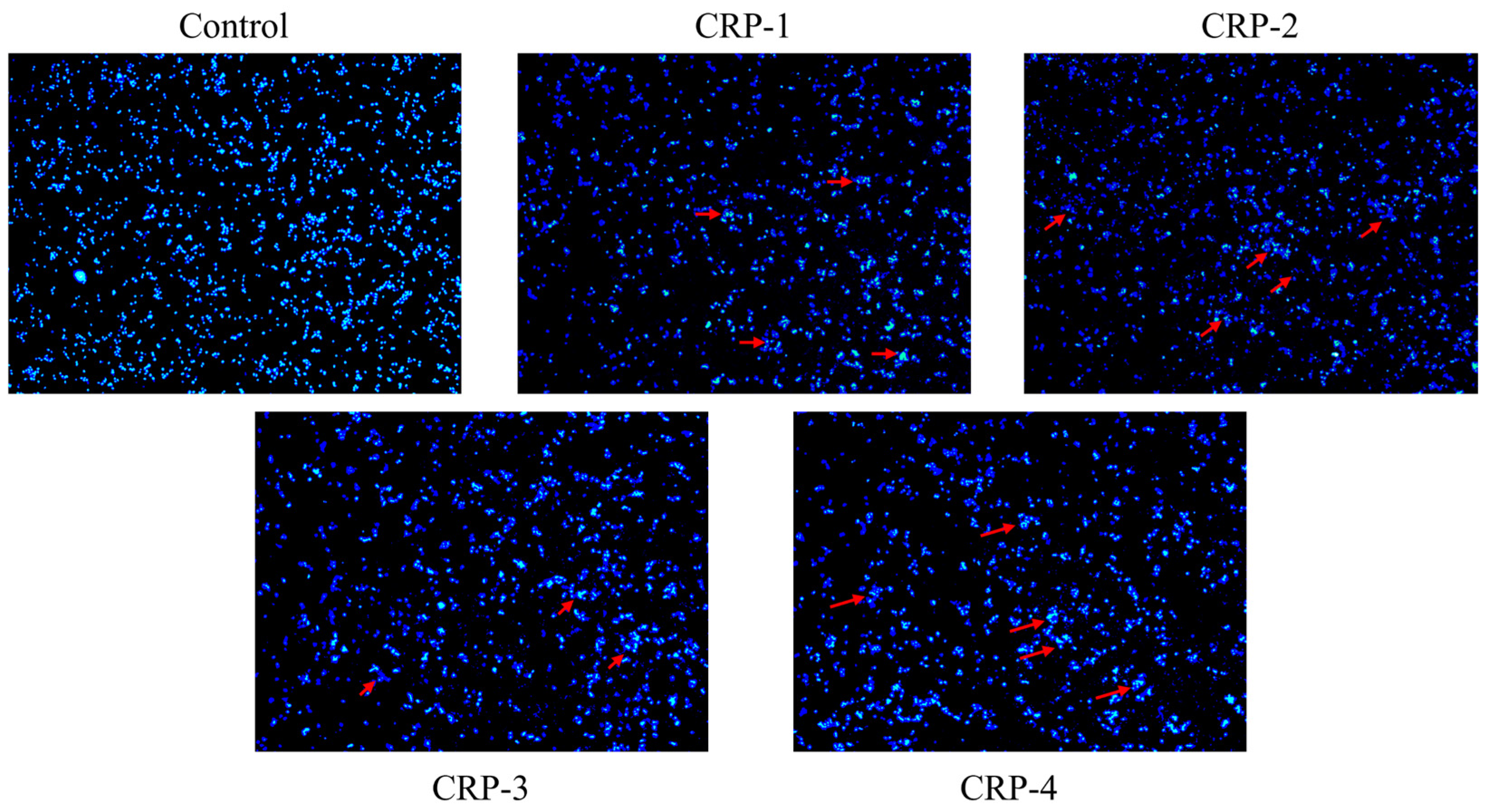
| Run Order | A/% | B/(g/mL_) | C/min | D/W | E/h | Extraction Yield/% |
|---|---|---|---|---|---|---|
| 1 | −1 | 1 | 1 | 1 | −1 | 5.26 |
| 2 | −1 | 1 | −1 | 1 | 1 | 5.37 |
| 3 | −1 | 1 | 1 | −1 | 1 | 5.27 |
| 4 | 1 | −1 | −1 | −1 | 1 | 4.5 |
| 5 | 1 | 1 | −1 | 1 | 1 | 5 |
| 6 | 1 | 1 | 1 | −1 | −1 | 5.25 |
| 7 | −1 | −1 | 1 | −1 | 1 | 4.77 |
| 8 | 1 | 1 | −1 | −1 | −1 | 5.1 |
| 9 | −1 | −1 | −1 | 1 | −1 | 4.45 |
| 10 | 1 | −1 | 1 | 1 | −1 | 4.23 |
| 11 | 1 | −1 | 1 | 1 | 1 | 4.29 |
| 12 | −1 | −1 | −1 | −1 | −1 | 4.8 |
| Source | Sum of Squares | df | Mean Square | F-Value | p-Value | Significance |
|---|---|---|---|---|---|---|
| Model | 1.78 | 5 | 0.3558 | 30.71 | 0.0003 | *** |
| A | 0.2002 | 1 | 0.2002 | 17.28 | 0.006 | *** |
| B | 1.48 | 1 | 1.48 | 127.48 | 0.0001 | *** |
| C | 0.0019 | 1 | 0.0019 | 0.1618 | 0.7014 | |
| D | 0.099 | 1 | 0.099 | 8.55 | 0.0265 | * |
| E | 0.001 | 1 | 0.001 | 0.087 | 0.7779 | |
| Residual | 0.0695 | 6 | 0.0116 | |||
| Cor Total | 1.85 | 11 |
| Run Order | A/% | B/W | C/(g/mL) | Extraction Yield/% |
|---|---|---|---|---|
| 1 | 2 | 150 | 25 | 5.27 |
| 2 | 1.5 | 250 | 30 | 5.25 |
| 3 | 1.5 | 150 | 20 | 5.04 |
| 4 | 1.5 | 150 | 30 | 5.08 |
| 5 | 1 | 250 | 25 | 5.41 |
| 6 | 1 | 200 | 30 | 5.43 |
| 7 | 1.5 | 200 | 25 | 5.57 |
| 8 | 1 | 200 | 20 | 5.04 |
| 9 | 1.5 | 250 | 20 | 4.97 |
| 10 | 1.5 | 200 | 25 | 5.78 |
| 11 | 2 | 200 | 30 | 5.43 |
| 12 | 1 | 150 | 25 | 5.2 |
| 13 | 2 | 250 | 25 | 5.35 |
| 14 | 1.5 | 200 | 25 | 5.73 |
| 15 | 2 | 200 | 20 | 5.25 |
| 16 | 1.5 | 200 | 25 | 5.64 |
| 17 | 1.5 | 200 | 25 | 5.48 |
| Source | Sum of Squares | df | Mean Square | F-Value | p-Value | Significance |
|---|---|---|---|---|---|---|
| Model | 0.8779 | 9 | 0.0975 | 9.04 | 0.0042 | *** |
| A | 0.0061 | 1 | 0.0061 | 0.5607 | 0.4784 | |
| B | 0.019 | 1 | 0.019 | 1.76 | 0.226 | |
| C | 0.099 | 1 | 0.099 | 9.18 | 0.0191 | * |
| AB | 0.0042 | 1 | 0.0042 | 0.3916 | 0.5513 | |
| AC | 0.011 | 1 | 0.011 | 1.02 | 0.3457 | |
| BC | 0.0144 | 1 | 0.0144 | 1.33 | 0.2859 | |
| A2 | 0.0178 | 1 | 0.0178 | 1.65 | 0.24 | |
| B2 | 0.3013 | 1 | 0.3013 | 27.92 | 0.0011 | *** |
| C2 | 0.348 | 1 | 0.348 | 32.26 | 0.0080 | *** |
| Residual | 0.755 | 7 | 0.0108 | |||
| Lack of fit | 0.0173 | 3 | 0.0058 | 0.3969 | 0.7631 | |
| Pure Error | 0.0582 | 4 | 0.0145 | |||
| Cor Total | 0.9534 | 16 |
| Factor | Condition Setting | ||||
|---|---|---|---|---|---|
| A (%) | 1 | 1.5 | 2 | 2.5 | 3 |
| B (W) | 100 | 150 | 200 | 250 | 300 |
| C (min) | 0 | 5 | 10 | 15 | 20 |
| D (g/mL) | 1:15 | 1:20 | 1:25 | 1:30 | 1:35 |
| E (h) | 1 | 1.5 | 2 | 2.5 | 3 |
| Level | Factor | ||||
|---|---|---|---|---|---|
| A (%) | B (g/mL) | C (min) | D (W) | E (h) | |
| −1 | 1 | 1:20 | 5 | 150 | 2 |
| 1 | 2 | 1:30 | 15 | 250 | 3 |
| Level | Factor | ||
|---|---|---|---|
| A: NaOH Mass Fraction/% | B: Ultrasonic Power/W | C: Solid-to-Liquid Ratio/(g/mL) | |
| −1 | 1 | 150 | 20 |
| 0 | 1.5 | 200 | 25 |
| 1 | 2 | 250 | 30 |
Disclaimer/Publisher’s Note: The statements, opinions and data contained in all publications are solely those of the individual author(s) and contributor(s) and not of MDPI and/or the editor(s). MDPI and/or the editor(s) disclaim responsibility for any injury to people or property resulting from any ideas, methods, instructions or products referred to in the content. |
© 2024 by the authors. Licensee MDPI, Basel, Switzerland. This article is an open access article distributed under the terms and conditions of the Creative Commons Attribution (CC BY) license (https://creativecommons.org/licenses/by/4.0/).
Share and Cite
Liang, Z.; Xiong, L.; Zang, Y.; Tang, Z.; Shang, Z.; Zhang, J.; Jia, Z.; Huang, Y.; Ye, X.; Liu, H.; et al. Extraction Optimization and Anti-Tumor Activity of Polysaccharides from Chlamydomonas reinhardtii. Mar. Drugs 2024, 22, 356. https://doi.org/10.3390/md22080356
Liang Z, Xiong L, Zang Y, Tang Z, Shang Z, Zhang J, Jia Z, Huang Y, Ye X, Liu H, et al. Extraction Optimization and Anti-Tumor Activity of Polysaccharides from Chlamydomonas reinhardtii. Marine Drugs. 2024; 22(8):356. https://doi.org/10.3390/md22080356
Chicago/Turabian StyleLiang, Zhongwen, Lan Xiong, Ying Zang, Zhijuan Tang, Zhenyu Shang, Jingyu Zhang, Zihan Jia, Yanting Huang, Xiaoyu Ye, Hongquan Liu, and et al. 2024. "Extraction Optimization and Anti-Tumor Activity of Polysaccharides from Chlamydomonas reinhardtii" Marine Drugs 22, no. 8: 356. https://doi.org/10.3390/md22080356





